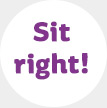Investing in an ergonomic office chair for you or your employees can help improve productivity and reduce the risk of workers developing health problems.
When choosing an office chair, take into account how long you will spend in it and whether you have any existing aches or pains. Look for comfort, adjustability and finish.
Here we have a list of features ergonomic chairs can offer, to help you select the right chair for you.
Height Adjustable Armrests
Your armrests should be adjusted so your shoulders are relaxed and your wrists are even with your keyboard.
Width Adjustable Armrests
Adjust the gap between the armrests. The arm rests should be positioned so your arms aren't wedged in or so you need to stretch out for support.
Adjustable Headrest
A headrest is helpful if you have neck or shoulder problems and they are usually used when the chair is slightly reclined. It allows the muscles in neck & shoulders to relax
Chair Recline Tilt
Allows the whole chair to tilt relative to the floor. The chair pivots from the central point under the seat, allowing your feet to come off the floor as you recline.
Knee Tilt
This feature means the chair will tilt from just under the knee. It means you can tilt back in your chair with your feet still on the floor. It allows movement without losing support.
Lock Tilt
Allows chair to be locked upright or allows free tilt.
Permanent Contact Mechanism
This lets you fix the angle of the backrest or set it to be free-floating to offer you constant support. Free floating means the backrest and seatpan move together in a reclining motion and the backrest is in permanent contact with your back.

•With your back straight and your shoulders back
•The normal curves of your back should be supported by the chair – some people may require additional lumbar support
•Your weight should be distributed evenly on both hips
•Your knees should be at a right angle and either even with or slightly higher than your hips – you can use a footrest if necessary.
•Keep your feet flat on the floor.
•You should try to avoid twisting or tilting at the waist when sat
It’s worthwhile to invest in an ergonomic chair, which will adapt to suit you.
Ergonomic chairs come with a variety of different features, some may have a number of features and others may just have one. View our full range of office chairs here


















